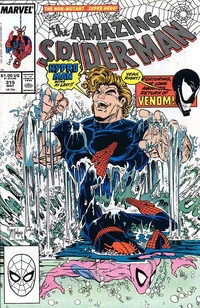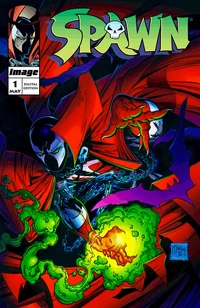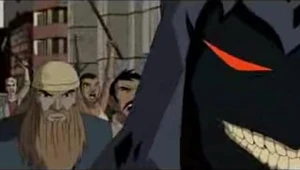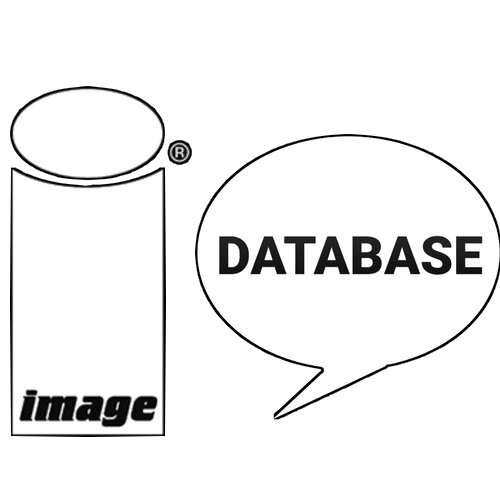Personal History
Todd is married to the editor, Wanda Kolomyjec.
Professional History
Todd McFarlane (born March 16, 1961 in Calgary, Alberta, Canada) is a Canadian cartoonist, comic book writer, artist, toy manufacturer/designer, and media entrepreneur.
In the late 1980s and early 1990s, McFarlane became a comic book superstar due to his work on both DC Comics' Infinity Inc. and Marvel Comics' Spider-Man franchises. In 1992, he helped form Image Comics, pulling the occult anti-hero Spawn from his high school portfolio and updating him for the 1990s. Spawn was one of the 1990s' most popular heroes and encouraged a trend in creator-owned comic book properties.
In recent years, McFarlane has illustrated comic books less often, focusing on entrepreneurial efforts, such as McFarlane Toys, whose meticulously detailed action figures have set new standards in the toy industry, and Todd McFarlane Entertainment, a film and animation studio.
In September, 2006, it was announced that McFarlane will be the Art Director of the newly formed Green Monster Games, founded by Curt Schilling.[1]
McFarlane is also co-owner of National Hockey League's Edmonton Oilers and a high-profile collector of history-making baseballs.
Biography
Early life
McFarlane was born in Calgary, Alberta. He graduated from William Aberhart High School. As a teenager, he discovered comic books and was a fan of stars such as John Byrne and Frank Miller, but was especially drawn to the more atypical art of Michael Golden and Art Adams (Adams' detailed but cartoonish approach had a noticeable influence on McFarlane's work). Gil Kane was also a major influence on McFarlane.
University
In the early-1980s, McFarlane attended Eastern Washington University on a baseball scholarship and studied graphic art. He sought to play baseball professionally after graduation but was not contracted by a professional team. During his time at EWU, McFarlane worked at a comic book shop in Spokane, Washington. Drawings he had done of Marvel and DC superheros were sold at local shops.
Early career

A cover by McFarlane while he was with Marvel Comics.
McFarlane's first published work was a 1984 backup story in Epic Comics' Coyote. He soon began working for both Marvel and DC Comics. He illustrated several issues of Marvel's Incredible Hulk and DC's Infinity Inc. and various Batman series. In 1987, McFarlane joined writer David Michelinie on Marvel's The Amazing Spider-Man. McFarlane changed the character's appearance, making him more spider-like with wiry limbs and large eyes. His interpretation would influence those of many subsequent Spider-Man artists. McFarlane also helped create Venom, a wildly popular villain. (director Sam Raimi came to McFarlane for the initial sketches of Venom for the Spider-Man 3 movie)
McFarlane's work on The Amazing Spider-Man turned him into an industry superstar. In 1990, after a 29-issue run of Amazing Spider-Man, McFarlane told editor Jim Salicrup he'd grown tired of drawing other peoples stories and would be leaving the book with issue 328 to write his own work. Jim offered Todd a new Spider-Man book prompting the launch of a new monthly series, simply called Spider-Man, which McFarlane both wrote and illustrated. Spider-Man #1 sold 2.5 million copies, partially due to the variant covers that were used to encourage collectors into buying more than one edition. Spider-Man #1 is seen by many as the beginning of the comic speculation boom that lasted through the first years of the 1990s (reaching its bust with DC Comics "Death Of Superman" storyline of mid-1993.) Issue 16 saw the replacement of editor Jim Salicrup with Danny Fingeroth. McFarlane wrote and illustrated the first 14 and issue 16 of Spider-Man before leaving the book altogether due to creative clashes with the new editor. Most issues were crossovers with characters such as Wolverine, Ghost Rider, and X-Force.
The Breakoff
McFarlane then left Marvel with six other popular artists to form Image Comics, an umbrella company under which each owned a publishing house. McFarlane's studio, Todd McFarlane Productions, published his creation, the occult-themed Spawn. Spawn #1 sold 1.7 million copies, still a record for an independent comic book.
Spawn

Spawn #1 (1992)
McFarlane was artist/writer for the first 7 issues. He brought on writers Alan Moore, Neil Gaiman, Dave Sim and Frank Miller for issues 8 to 11 (respectively) while McFarlane continued with art chores. He continued on as writer to issue 15, bringing on Grant Morrison and Greg Capullo for the following three issues. He returned as writer/artist for issue 21 and remained so until issue 24. Greg Capullo took over as pencil artist with issue 26, McFarlane remained writer and inker on the book until issue 73.
McFarlane eventually would hand off scripting duties (while still overseeing plotlines) to other writers, and the book continued to retain a respectable following. He has story input and inks covers on occasion.
In 2006 McFarlane announced plans for Spawn/Batman with artist Greg Capullo which McFarlane will write and ink. He also began taking an active role in comics publishing again, publishing collections of his Spawn comics in paperback form. The first collecting issues 1-12 minus issue 9 (due to royalty issues with Neil Gaiman) and 10 (due to a vow he made to Sim) was a success in December of 2005. The second collecting issues 13-33 was due at the end of July 2006.
Controversial Statements
McFarlane's defense of the Image Comics ethic during its early years led to a noteworthy "style versus substance"-themed feud with comic book writer Peter David. McFarlane's assertion was that comic writers were secondary in importance to artwork in terms of commercial success.
This came to a head during a public debate they participated in at Philadelphia's Comic Fest convention in November 1993, which was moderated by artist George Perez. The topic of the debate was McFarlane’s claim that Image was not being treated fairly by the media, and by David’s weekly "But I Digress" column in the Comics Buyer's Guide in particular. The three judges, Maggie Thompson, editor of the Comics Buyer's Guide, William Christensen of Wizard Press, and John Danovich of the magazine Hero Illustrated, voted 2-0-1 in favor of David, with Danovich voting the debate a tie.
McFarlane Entertainment
Todd McFarlane Productions has also published multiple Spawn spin-off mini-series, but, unlike other Image studios, such as Jim Lee's Wildstorm, McFarlane's studio was never intended to focus on being a comic book company, and had always intended to diversify into other areas. McFarlane increasingly concentrated his own personal attention to those other ventures, which resulted in irregular work as an illustrator. By 1994, he ceased to be the regular illustrator of his own "signature" book, and would only re-visit Spawn sporadically, or as a promotional stunt for the title.

A scene from the music video of Disturbed's Land of Confusion.
That same year, McFarlane created McFarlane Toys. Its line of meticulously sculpted Spawn action figures changed the entire industry by focusing on more mature consumers and non-traditional action figure inspirations such as musicians. The company has licensed the right to produce action figures of athletes in all four major North American sports -- baseball, hockey, football and basketball -- and several recent, successful film franchises, including The Terminator, The Matrix and Shrek. It has also created figures of rock musicians, including Jim Morrison, Jimi Hendrix and the members of KISS.
In 1996, McFarlane founded Todd McFarlane Entertainment, a film and animation studio. In collaboration with New Line Cinema, it produced the 1997 Spawn film and the sequel Spawn 2: The movie, planned for 2007.[2] Spawn, while critically panned, was a modest box office success, earning $54.97 million domestically, a little over $69 million worldwide. It also produced the animated series Todd McFarlane's Spawn (featuring voice work by actor Keith David), which aired on HBO from 1997 until 1999. The animated series received significantly more positive press than the film, and was a moderate success when eventually released on DVD.
The studio has produced acclaimed music videos for Pearl Jam's "Do the Evolution" (1998), KoЯn's "Freak on a Leash" (1999) and Disturbed's "Land of Confusion" (2006). They also produced an animated segment of the film The Dangerous Lives of Altar Boys (2002).
Sports
McFarlane is an avid baseball fan; he briefly tried to achieve a pro career in the sport as a young adult. McFarlane has bought, at auction, multiple balls from Mark McGwire and Sammy Sosa's 1998 race to establish a record for the greatest number of home runs hit in a single season. McFarlane owns Sosa's 33rd, 61st and 66th home run balls, and McGwire's first, 63rd, 67th, 68th, 69th and 70th (McGwire's 61st was the ball which tied Roger Maris' then-record, while McGwire's 70th set a new record -- broken in 2001 by Barry Bonds). He later purchased Bonds' record breaking 73rd home run ball for $450,000.
In late 2001, McFarlane revealed a new logo for the Edmonton Oilers NHL franchise of which he is a part-owner. This logo is featured on the team's Third Jersey.
Some years ago, Curt Schilling of the Boston Red Sox, has teamed up with McFarlane, forming Green Monster Games, LLC. This gaming studio featured McFarlane's art direction and also R.A. Salvatore as creative director. The studio's focus was toward massive multiplayer online games, of which Schilling is an avid fan.
Other Media
In December 2002, Todd McFarlane directed the music video "Breath" for Canadian hip-hop group Swollen Members that featured Nelly Furtado. He later drew both the Canadian and International covers for their next album "Heavy," released October 2003.
McFarlane also created the character Necrid for the console versions of the video game Soul Calibur II.
In January of 2005, McFarlane announced that he was set to produce a half-hour anthology television series for Fox called Twisted Tales, based on the Bruce Jones' comic book to which McFarlane had purchased the rights.[3] According to the Internet Movie Database, McFarlane will serve as the series' narrator/host. [4]
Todd McFarlane is also the cartoonist responsible for the cover art of the album Ten Thousand Fists, released in September 2005 by heavy metal band Disturbed, as well as that of metal band Iced Earth's 1996 Spawn-based concept album The Dark Saga.
Lawsuits
McFarlane lost judgements in two lawsuits in the 2000s. The first was a 2002 suit in which McFarlane contested with writer Neil Gaiman over the rights to some supporting Spawn characters created by Gaiman in issue #9 of the Spawn series and over payment for later works featuring those characters. In 1997 the two signed a deal in which Gaiman would give his share of characters Angela, Medieval Spawn and Cogliostro to McFarlane in exchange of McFarlane's share of British superhero Miracleman (in reality, what McFarlane actually owned were two trademarks for Miracleman logos, not the character, which would become clear only after the lawsuit concluded). However, this deal was broken by McFarlane, which motivated Neil Gaiman to start the lawsuit. The jury was unanimous in favor of Gaiman. (The two are now involved in a dispute over ownership of Miracleman, but no lawsuit has been filed in that dispute.)
The second was a December 2004 suit in which hockey player Tony Twist sued Todd McFarlane because he named a mobster character in Spawn after real-life Twist.
Awards
- Todd McFarlane's work has won him numerous awards over the years, including a 1992 National Cartoonists Society Award for Best Comic Book.
- Todd received football's Artist of the Year award for 2005, for his work on program covers for the Baltimore Ravens.
Method
Todd McFarlane generally uses the same method when designing his heroes. They will be humanoid, big and arguably ugly, with glowing eyes and (often) sharp teeth. They will be anti-heroes with some form of relation to death. Often their name will be a play on words that relates to this, or another sinister sounding word. They will often either be robed, caped, or just spiky.
Work History
- 130 subject(s) created by "Todd McFarlane"
- 3 work(s) that were produced while "Todd McFarlane" was Editor-in-Chief
- 197 work(s) where "Todd McFarlane" worked on a cover
- 100 work(s) that "Todd McFarlane" edited
- 302 work(s) that "Todd McFarlane" wrote
- 52 work(s) that "Todd McFarlane" penciled
- 155 work(s) that "Todd McFarlane" inked
- 17 work(s) that "Todd McFarlane" worked as Producer
Images
- 126 cover(s) "Todd McFarlane" worked on
- 32 image(s) "Todd McFarlane" worked on as penciler
- 45 image(s) "Todd McFarlane" worked on as inker
Trivia
- A picture of McFarlane appears in Spawn #83. Sam Burke reads an article about "some nutty foreigner" who has bought a baseball for $3 million. Earlier that year, McFarlane himself had bought the record-breaking 70th home run baseball of Mark McGwire for the same amount. In one panel, Todd McFarlane's picture is visible, with his name typed barely visible next to it. Burke continued to complain, "Look at this clown. What a tool! Man, I HATE rich people."
- Todd McFarlane's designs were parodied in the internet comic strip Penny Arcade through the character of Dr. Raven Darktalon Blood.
- Todd McFarlane had a letter published in The New Adventures of Superboy #23, November 1981. The issue under discussion was #18 of the same series.
See Also
Links and References
- Spawn.com features a biography and info about McFarlane's work
- press release on twist issue latest on twist issue
- Todd McFarlane credits on Spider-Man
- Comic Book Awards Almanac
- Interview on SuicideGirls
- Interview - Now Playing magazine
- Todd McFarlane's work on Marvel.com
